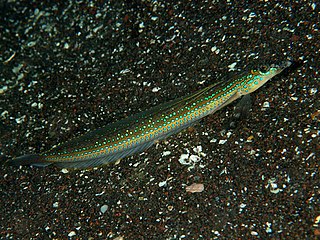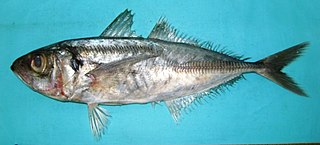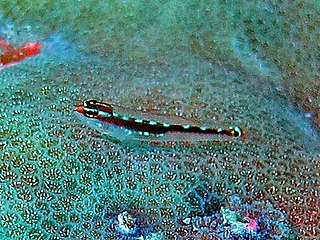
The grey triggerfish or gray triggerfish is a ray-finned fish in the triggerfish family. The species is native to shallow parts of the western Atlantic from Nova Scotia to Argentina and also the eastern Atlantic, the Mediterranean Sea and off Angola on the west coast of Africa.

The smooth grouper is a species of marine ray-finned fish, a grouper from the subfamily Epinephelinae which is part of the family Serranidae, which also includes the anthias and sea basses. It is associated with reefs and is found in the western Indian Ocean.

Trichonotus is a genus of marine gobiiform fishes. Species of Trichonotus are distributed throughout the Indo-West Pacific. This genus is the only member of the family Trichonotidae.

Cephalopholis miniata, also known as the coral grouper, coral hind, coral rock cod, coral cod, coral trout, round-tailed trout or vermillion seabass is a species of marine ray-finned fish, a grouper from the subfamily Epinephelinae which is in the family Serranidae which also includes the anthias and sea basses. It is associated with coral reefs and occurs in the Indo-Pacific.

The spotted sand-diver is a perciform fish in the family Trichonotidae. T. setiger is the type species of genus Trichonotus.
Scorpaena azorica is a scorpionfish located in the Northeastern Atlantic region in European waters commonly known as the Azores scorpionfish. This fish is found in demersal and marine environments in subtropical waters, generally on hard bottoms. The maximum recorded length is 9.8 centimetres (3.9 in).

Dollfus' stargazer is a fish of the family Uranoscopidae, widespread in the Western Indian Ocean: Gulf of Suez, Gulf of Oman, and Persian Gulf. It is a marine demersal fish, and occurs at depths down to about 46 metres (151 ft). It was named in honour of Dr R. P. Dollfus who led an expedition to Egypt in 1928–1929 and who brought back some specimens of this fish which he mistakenly identified as Uranoscopus affinis. These were new to science and became the type specimens of the new species U. dollfusi, with the Gulf of Suez being the type locality.

The red gurnard, also known as the East Atlantic red gurnard, is a fish species of Triglidae family. Widespread in the Eastern Atlantic from British Isles to Mauritania. Also known throughout the Mediterranean and possibly in the Black Sea.

The Menticirrhus americanus, southern kingfish, southern kingcroaker, king whiting, Carolina whiting, sea mullet, or whiting is a species of marine fish in the family Sciaenidae. It lives in shallow coastal waters on the western fringes of the Atlantic Ocean.
Halichoeres zulu, the Kwa-Zulu Natal wrasse, is a species of ray-finned fish from the family Labridae, the wrasses. It is native to the south western Indian Ocean. It was first described in 2010.

Parapercis hexophtalma, the speckled sandperch, is a species of marine bony fish in the family Pinguipedidae, found in the western Indo-Pacific Ocean. It was first described by the French naturalist Georges Cuvier in 1829. There are several synonyms, some of which represent misspellings of the original name, and others which were given to female fish, at the time thought to be a separate species.

Parapercis maculata, the harlequin sandperch, is a species of marine bony fish in the family Pinguipedidae, found in shallow waters in the tropical western Indo-Pacific Ocean.

Parapercis alboguttata, the bluenose grubfish, known also as the bluenose sandperch and whitespot sandsmelt, is a species of marine bony fish in the family Pinguipedidae, native to the western Indo-Pacific Ocean. It was first described by the German-born, British ichthyologist and zoologist, Albert Günther, in 1872.

Scorpaenopsis barbata, common name bearded scorpionfish, is a species of scorpionfish belonging to the family Scorpaenidae.
Gerres nigri, the Guinean striped mojarra is a species of mojarra native to the eastern Atlantic Ocean. It inhabits estuaries, coastal waters and lagoons. This species can reach a maximum length of 20 cm (8 in), with 15 cm (6 in) being a more common size.

The Arabian scad is a species of jack mackerel from the family Carangidae which is found in the Western Indian Ocean.
Pteragogus trispilus is a species of marine ray-finned fish from the wrasse family, the Labridae. It is native to the Red Sea from where it has entered the Mediterranean Sea.

Eviota sebreei, common name Sebree's pygmy goby or striped dwarfgoby, is a species of fishes belonging to the family Gobiidae.

Chaetodon nigropunctatus, the black-spotted butterflyfish, is a species off marine ray-finned fish, a butterflyfish, belonging to the family Chaetodontidae. It is found in the north western Indian Ocean.
The Oman butterflyfish is a species of marine ray-finned fish, a butterflyfish belonging to the family Chaetodontidae. It is native to the northwestern Indian Ocean.













